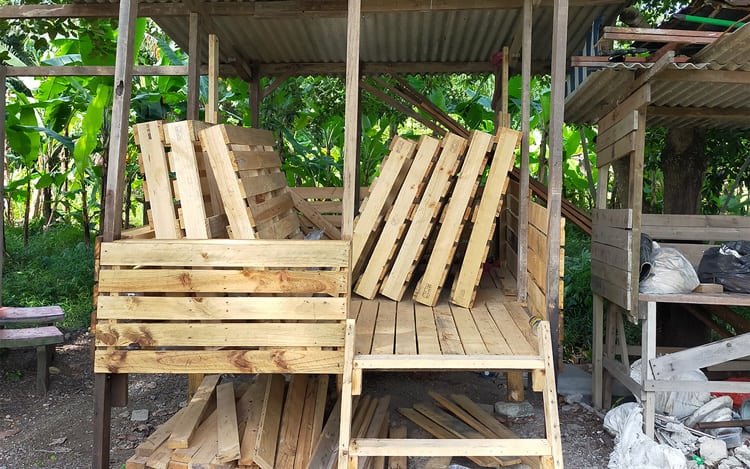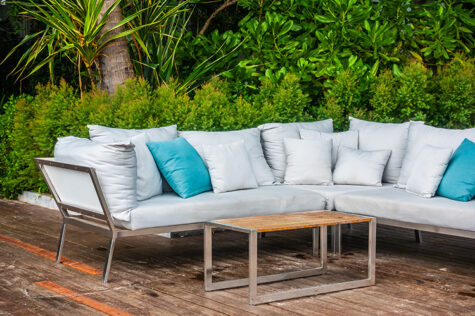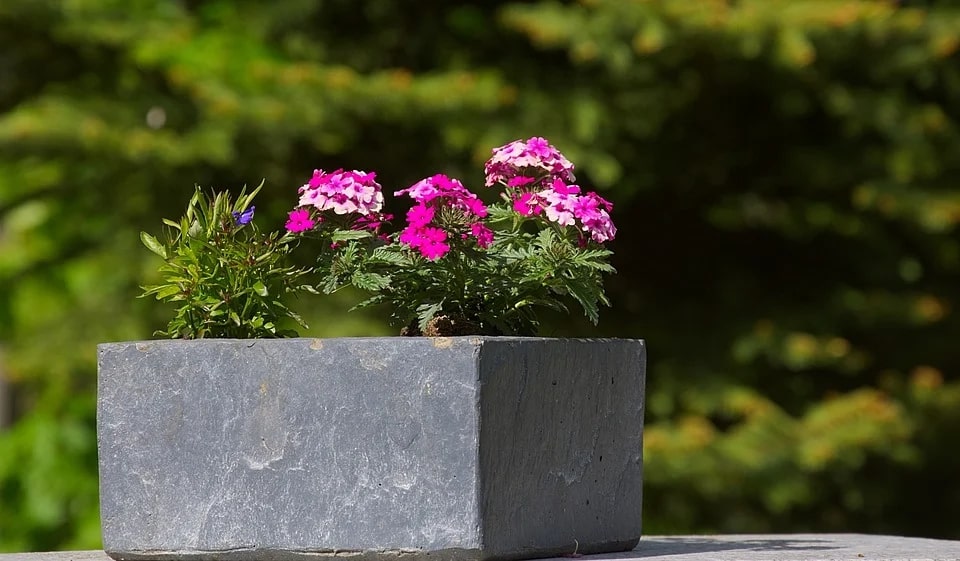Replacing your outdoor cushions can be a very expensive exercise, but it doesn’t have to be. Making your own outdoor cushions is much more cost-effective. It’s also a fun project that will keep you busy for a while.

Credit: Pixabay
If you like DIY projects or just can’t afford to spend too much on new outdoor cushions, then this article is for you. Let’s take a look at how to make cushions for garden furniture.
Necessary Supplies
Before you rush off to buy the material of your dreams, make sure you have a list of supplies so you don’t forget anything. Here’s what you’ll need:
- Outdoor fabric of your choice
- Outdoor cushion filling
- Zips the length of your individual cushions
- Sewing pins
- A sewing machine
- Thread that matches your material
- A measuring tape
- Fabric scissors
- Carpet knife
- A pen or pencil for writing on fabric
- Sewing glue (if you’re going the no-sew route)
- Plywood (For no-sew cushions)
- An upholstery stapler (For the no-sew route)
Once you’ve decided if you’re up for sewing or if you’d prefer not to sew at all, you can start your DIY project.
Wait! One more thing before you run to the shops, make sure to take some measurements first so you know how much fabric you’ll need. Here’s how to get your project started:
Method 1: Sewing
This part of the article is for those who like to sew and are up for the challenge. Let’s get started and create some stunning patio cushions!
Step 1: Determine the size of your cushions
Before you can do anything, you’ll need to determine how big your cushions need to be. If you have existing cushions, you can simply use your measuring tape and take some measurements. Make sure to write down your measurements so you don’t forget.
If you don’t have any cushions at all, you can measure the seating area and backrest of your furniture to determine how big the cushions need to be. Once you’ve taken all the measurements you can calculate how much fabric and cushion filling will be required.
Note: Make sure to determine length, width and height when measuring your cushions. Also, keep in mind that you need enough fabric to cover the whole cushion, front and back. Too much fabric is always better than too little so make sure to get a bit extra just in case.
Step 2: Measure and cut your fabric
Once you’ve run to the store and got everything you need, it’s time to start creating some cushion covers. Lay your fabric out on a large table or on the floor and use your previous measurements to measure out individual panels. You should end up with 6 panels for every cushion. Make sure to allow each panel to be around 1 cm ( 0.4 of an inch) larger than your measurements.
Use the fabric pen or pencil to draw straight lines to use as a guide for cutting the fabric. Once you’re sure of your measurements, use fabric scissors to cut out the panels. Place them somewhere on a table or on the ground in the form of a cross with each panel bordering the central piece in the way it will be sewed together.
Step 3: Pin and sew

Credit: Pxhere
Once your material is cut and laid out, you can pin the edges together. Use the extra 1 cm (0.4 of an inch) to create a small overlap. This will make sewing easier later. Also, make sure the overlap is on the side that will be on the inside of your cushion. While constructing your cushion cover, you’ll be working with it turned inside out.
Once you’ve pinned all the sides, you can start the sewing process. Simply start at a corner and sew along the straight line you’ve created with your pins. Every time you reach a pin, simply remove it and move on. Do this for every side. First, create a nice straight line with pins and then sew on the panel.
You will need to connect all the sides until everything is sewed on except for one of the side panels. For this last panel, you’ll need to change your method a little bit to put in a zip.
Step 4: Placing the zip
When all your panels are sewn on except for one, you can insert your zip. Use the material sides of the zip to attach it to your little overlap and pin it in place. Just make sure the grip will be on the outside of the cushion once you’re done.
Now you can continue sewing the same as before and attach your last panel and the zip. Once complete, you can finally turn your cushion cover inside out through the open zip and inspect your work.
Step 5: Prepare the filling
Now that the first half of your project is complete, it’s time to complete your journey. Place your cushion filling on a table to make it easier to work with. Get your previous measurements out and start measuring the filling. You can use the fabric pen or pencil again to draw accurate lines.
Once you’re sure of the measurements, cut your cushion stuffing by either using scissors or a carpet knife. I’ve found that a carpet knife works much better and is easier to use.

Credit: Shutterstock
If your filling isn’t long enough to span the whole length of your cushion, simply add pieces until you have the correct length. Now it’s time to stuff your new cushion cover.
Step 6: The final step
Now we’ve reached the last step of this process. Everything is sewn into place and the filling is ready. All you have to do now is stuff the filling into the cushion cover. It will be a tight fit so some force might be necessary to get it in. Once in, close the zip and bam, all done. Now you can finally put your new patio cushions on your furniture and try them out.
If you want to make sure they are waterproof, you can use a sealant spray made for outdoor cushions. This isn’t necessary if your cushions will come inside when not in use, but recommended anyway to keep them clean and looking great.
More on this: Can Garden Furniture Cushions Be Left Outside?
Method 2: No sewing
If you don’t have a sewing machine or sewing is just not your thing, then this method is a good alternative. Let’s take a look at what you’ll need to know for this project.
Step 1: Take some cushion measurements
This step is exactly the same as in the previous method. If you didn’t look at the first method, no worries, just continue reading, everything is repeated here.
Before you can do anything, you’ll need to determine how big your cushions need to be. If you have existing cushions, you can simply use your measuring tape and take some measurements. Make sure to write down your measurements so you don’t forget.

Credit: Shutterstock
If you don’t have any cushions at all, you can measure the seating area and backrest of your furniture to determine how big your cushions need to be. Once you’ve taken all the measurements you can calculate how much fabric and cushion filling will be required as well as the size of the plywood sheets you’ll need to get. Make sure to leave some material for a slight overlap with the plywood.
Note: Make sure to determine length, width and height when measuring your cushions. Also, keep in mind that you only need enough fabric to cover the top and sides of your cushion since the plywood will take care of the bottom. Too much fabric is always better than too little, however, so make sure to get a bit extra just in case.
Step 2: Measure and cut your fabric
Once you’ve run to the store and got everything you need, it’s time to start creating some cushion covers. Lay your fabric out on a large table or on the floor and use your previous measurements to determine how big the cover will need to be. You should end up with one large panel that covers the whole cushion except for the bottom. Make sure to allow for some extra material to work with while doing the upholstering part of your project.
Around 3 cm (1 inch) all around should be enough material to work with. If you’re worried, you can leave up to 15 cm (6 inches) all around to work with. That does mean you need to get some extra fabric so keep that in mind.
Use the fabric pen or pencil to draw straight lines to use as a guide for cutting the fabric. Once you’re sure of your measurements, use fabric scissors to cut out the panels. Place the panel somewhere on a table or on the floor with the bland side of the fabric facing up.
Step 3: Prepare the filling
Place your cushion filling on a table to make it easier to work with. Get your previous measurements out and start measuring the filling. You can again use the fabric pen or pencil to draw accurate lines. Once you’re sure of the measurements, you can cut your cushion stuffing by either using scissors or a carpet knife. I’ve found that a carpet knife works much better and is easier to use.
If your filling isn’t long enough to span the whole length of your pillow, simply add pieces until you have the correct length. Once done, place your cushion filling in the middle of your cut fabric.
Step 4: Prepare the plywood
Now comes the woodwork part of this project. It is recommended to have the plywood cut professionally. If you didn’t have the plywood cut professionally or it wasn’t an option for you, you’ll now have to do it yourself.
Start by getting out your measurements out again. Measure the plywood and draw lines with a pencil to make sure you cut it square. Also, make sure to cut the plywood bottom about 3 cm (1.2 inches) smaller than the cushion filling all around. In other words, the filling must have an overhang of about 3 cm (1.2 inches) on all sides of the plywood.
Your plywood is now ready to join the stack. Place it in the middle of the cushion filling. You’re ready to start upholstering.
Step 5: Upholstering
You’ve now created a neat stack with your fabric at the bottom, your cushion filling on top of the fabric and your plywood on top of everything. Now it’s time to do some stapling. Get your upholstery stapler ready and let’s begin.
The first thing you’ll have to do is pull the fabric neatly onto the plywood and make sure about 3 cm (1.2 inches) overlaps the wood. Staple the fabric in place. Do this all along the first side, but make sure the fabric is neat with no creases.
Once you’ve finished the first side, you’ll go to the side opposite your starting point. You might have to put a bit of muscle into pulling about 3 cm (1.2 inches) of fabric onto the plywood. Make sure to create a straight line just like on the other side. Make sure everything is neatly tensioned and staple the fabric into place.

Credit: Shutterstock
Now you’ll have to start in the middle of one of the remaining sides. Tension the fabric with the same overlap as the other two sides. Once you reach a corner, you can neatly fold the fabric over it to prevent any nasty creases. The fold will also round it off nicely. Do the same with the other corner and the remaining side.
Once everything is done you can cut away any unnecessary fabric and flip your new cushion around. Inspect your work and test it out on your furniture.
FAQs
What type of filling do you use for outdoor cushions?
The best filling for outdoor cushions is called cumulus filling. It is made from densified, layered poly fibre and dry conjugate. This filling is quite soft and very hardy making it an excellent choice for outdoor use.
How do you make outdoor cushions without sewing?
There are two ways to make outdoor cushions without sewing. In the one method, you’ll be stapling the fabric onto plywood. In the other method, you can use sewing glue to secure the seams together instead of using thread to keep them closed.
How to make outdoor cushions more comfortable?
The best way to make outdoor cushions more comfortable is to replace the old stuffing with the new filling. Make sure the new filling is to your liking, cut it into the right dimensions and stuff it into your cushion covers. If necessary, you can also add plywood to the back to create more stability and support.

Save this pin for later






